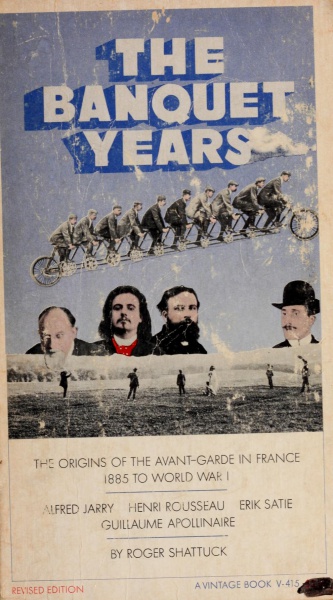Roger Shattuck: The Banquet Years: The Origins of the Avant-Garde in France, 1885 to World War I., Rev. ed. (1955/1968)
Filed under book | Tags: · 1880s, 1890s, 1900s, 1910s, absurd, anarchism, art, art history, avant-garde, cubism, dada, dreams, france, literature, logic, montage, music history, painting, pataphysics, poetry, theatre, typography

In this book Roger Shattuck portrays the cultural bohemia of turn-of-the-century Paris who carried the arts into a period of renewal and accomplishment, and laid the ground-work for Dada and Surrealism.
“…Then came the idea–a kind of gambler’s hunch–that the trio Rousseau-Satie-Apollinaire represented several significant aspects of the period and could reveal them better than any single figure. The idea would not die. [..] Jarry had forced his way into the group and established himself close to the center of things. He helped clarify my underlying subject: how the fluid state known as bohemia, a cultural underground smacking of failure and fraud, crystallized for a few decades into a self-conscious avant-garde that carried the arts into a period of astonishingly varied renewal and accomplishment. [..] An enormous amount has been written on this era and these men since the first edition of this book in 1958. I have taken account of some of it by changing those passages where new facts have come to light.” (from the Preface to this edition)
First published in 1955
Publisher Vintage Books, 1968
397 pages
Review (Alfred Kazin, The Reporter, 1958)
Review (Sidney Tillim, College Art Journal, 1959)
Review (Justin O’Brien, The Saturday Review, 1958)
PDF (115 MB, no OCR)
Comment (0)Andreas Killen: Berlin Electropolis: Shock, Nerves, and German Modernity (2006)
Filed under book | Tags: · 1880s, 1890s, 1900s, 1910s, berlin, city, electricity, germany, history, modernity, neurasthenia, psychiatry, telephone, weimar republic

“Berlin Electropolis ties the German discourse on nervousness in the late nineteenth and early twentieth centuries to Berlin’s transformation into a capital of the second industrial revolution. Focusing on three key groups—railway personnel, soldiers, and telephone operators—Andreas Killen traces the emergence in the 1880s and then later decline of the belief that modernity caused nervous illness. During this period, Killen explains, Berlin became arguably the most advanced metropolis in Europe. A host of changes, many associated with breakthroughs in technologies of transportation, communication, and leisure, combined to radically alter the shape and tempo of everyday life in Berlin. The resulting consciousness of accelerated social change and the shocks and afflictions that accompanied it found their consummate expression in the discourse about nervousness.”
Wonderfully researched and clearly written, this book offers a wealth of new insights into the nature of the modern metropolis, the psychological aftermath of World War I, and the operations of the German welfare state. Killen also explores cultural attitudes toward electricity, the evolution of psychiatric thought and practice, and the status of women workers in Germany’s rapidly industrializing economy. Ultimately, he argues that the backlash against the welfare state that occurred during the late Weimar Republic brought about the final decoupling of modernity and nervous illness.
Publisher University of California Press, 2006
Weimar and Now: German Cultural Criticism, Volume 38
ISBN 0520931637, 9780520931633
303 pages
review (Eric J. Engstrom, H-German)
review (Harry Oosterhuis, History of Psychiatry)
Ian Britain: Fabianism and Culture. A Study in British Socialism and the Arts, c. 1884–1918 (2005)
Filed under book | Tags: · 1880s, 1890s, 1900s, 1910s, art, political theory, socialism, united kingdom

“This book is an attempt to remedy the neglect of the cultural and aesthetic aspects of English socialism in the late nineteenth and twentieth centuries. An outstanding symptom of this neglect is the way in which the Fabian Society, and its two leading lights, Sidney and Beatrice Webb, have usually been depicted as completely indifferent to art and to the artistic ramifications of socialism. Most commentators have painted Fabian socialism as a narrowly utilitarian programme of social and administrative reform, preoccupied with the mechanisms of politics and largely obvious of wider, more ‘human’ issues. One of the basic aims of the book is to question this bleakly philistine image, by showing the basis of the Fabians’ beliefs in romancism as well as utilitarianism.”
Publisher Cambridge University Press, 2005
ISBN 0521021294, 9780521021296
360 pages
PDF (updated on 2016-9-8)
Comment (0)
